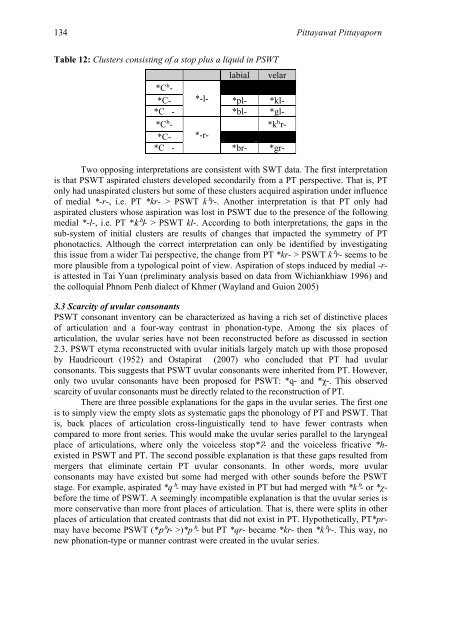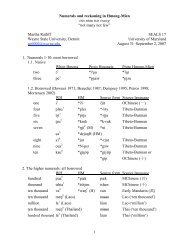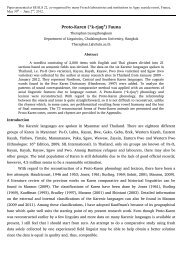proto-southwestern-tai revised: a new reconstruction - seals 22
proto-southwestern-tai revised: a new reconstruction - seals 22
proto-southwestern-tai revised: a new reconstruction - seals 22
Create successful ePaper yourself
Turn your PDF publications into a flip-book with our unique Google optimized e-Paper software.
134 Pittayawat Pittayaporn<br />
Table 12: Clusters consisting of a stop plus a liquid in PSWT<br />
labial velar<br />
*Cʰ-<br />
*C- *-l- *pl- *kl-<br />
*C -<br />
*bl- *gl-<br />
*Cʰ- *kʰr-<br />
*C- *-r-<br />
*C -<br />
*br- *gr-<br />
Two opposing interpretations are consistent with SWT data. The first interpretation<br />
is that PSWT aspirated clusters developed secondarily from a PT perspective. That is, PT<br />
only had unaspirated clusters but some of these clusters acquired aspiration under influence<br />
of medial *-r-, i.e. PT *kr- > PSWT kʰr-. Another interpretation is that PT only had<br />
aspirated clusters whose aspiration was lost in PSWT due to the presence of the following<br />
medial *-l-, i.e. PT *kʰl- > PSWT kl-. According to both interpretations, the gaps in the<br />
sub-system of initial clusters are results of changes that impacted the symmetry of PT<br />
phonotactics. Although the correct interpretation can only be identified by investigating<br />
this issue from a wider Tai perspective, the change from PT *kr- > PSWT kʰr- seems to be<br />
more plausible from a typological point of view. Aspiration of stops induced by medial -r-<br />
is attested in Tai Yuan (preliminary analysis based on data from Wichiankhiaw 1996) and<br />
the colloquial Phnom Penh dialect of Khmer (Wayland and Guion 2005)<br />
3.3 Scarcity of uvular consonants<br />
PSWT consonant inventory can be characterized as having a rich set of distinctive places<br />
of articulation and a four-way contrast in phonation-type. Among the six places of<br />
articulation, the uvular series have not been reconstructed before as discussed in section<br />
2.3. PSWT etyma reconstructed with uvular initials largely match up with those proposed<br />
by Haudricourt (1952) and Ostapirat (2007) who concluded that PT had uvular<br />
consonants. This suggests that PSWT uvular consonants were inherited from PT. However,<br />
only two uvular consonants have been proposed for PSWT: *q- and *χ-. This observed<br />
scarcity of uvular consonants must be directly related to the <strong>reconstruction</strong> of PT.<br />
There are three possible explanations for the gaps in the uvular series. The first one<br />
is to simply view the empty slots as systematic gaps the phonology of PT and PSWT. That<br />
is, back places of articulation cross-linguistically tend to have fewer contrasts when<br />
compared to more front series. This would make the uvular series parallel to the laryngeal<br />
place of articulations, where only the voiceless stop*ʔ- and the voiceless fricative *h-<br />
existed in PSWT and PT. The second possible explanation is that these gaps resulted from<br />
mergers that eliminate cer<strong>tai</strong>n PT uvular consonants. In other words, more uvular<br />
consonants may have existed but some had merged with other sounds before the PSWT<br />
stage. For example, aspirated *qʰ- may have existed in PT but had merged with *kʰ- or *χ-<br />
before the time of PSWT. A seemingly incompatible explanation is that the uvular series is<br />
more conservative than more front places of articulation. That is, there were splits in other<br />
places of articulation that created contrasts that did not exist in PT. Hypothetically, PT*pr-<br />
may have become PSWT (*pʰr- >)*pʰ- but PT *qr- became *kr- then *kʰr-. This way, no<br />
<strong>new</strong> phonation-type or manner contrast were created in the uvular series.





